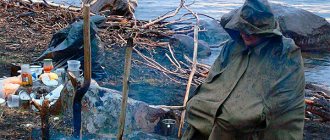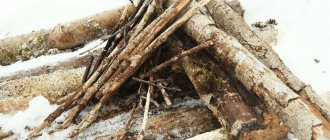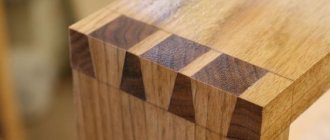Nodya is a taiga long-burning, or rather smoldering, fire, which is most often used for spending the night in the forest without a sleeping bag or tent in the winter season.
The main feature of Nodya is long burning. This is the longest-burning fire that does not require frequent adding of firewood, and if properly organized, it burns all night and allows a person to spend the night in the forest at low temperatures without unnecessary hassle. There are known cases of successful safe overnight stays with a node in the forest without sleeping equipment at minus 20°C - minus 30°C.
Due to the complexity of preparation, this fire is used mainly at low temperatures and, as a rule, in bivouacs intended for several overnight stays.
Classic node made of two logs held by stakes
The classic node consists of two even, fairly thick logs, one of which lies on the other. Due to this, such a node is also called vertical. In this fire, the fire burns with a weak flame between the logs along their entire length, providing warmth to the person lying opposite.
The incorrect name for a fire is nadya. This mistake is made simply out of ignorance. The fire is often also called “Siberian Nodya” and “taiga Nodya”, but these terms mean the same thing.
There are several options for making a node, differing in the complexity of the design, the duration of combustion, the need for support during the night and the amount of heat generated. Under different conditions, one design or another is more preferable, and sometimes the only acceptable one. At the same time, in order for the fire to flare up and not go out while a person sleeps (which is fraught with freezing), it is necessary to comply with the requirements for the preparation of firewood, installation of the fire and its operation.
Nodi options
There are at least three main options for constructing a node.
The “classic” (vertical) node consists of two logs, one of which lies on the other. This option is quite capricious, produces relatively little heat, but burns longer than other types of fires. It can be recommended when there is a lack of fuel or in cases where disproportionately more effort and time will be spent on harvesting excess logs compared to the benefits received from the fire.
In the photo there is such a node:
The “lazy” node is made of three logs, two of which lie on the ground close to each other, and the third is located parallel to the first two in the groove formed between them. This option is so unpretentious that it will continue to burn even if a snowdrift falls on it from a spruce branch. However, to fold it, you need to select the right logs and place them relative to each other.
The video shows how to make a lazy node:
Unlike the classic version, a lazy node lights up more easily, burns brighter and releases more heat, but also burns out faster. For an overnight stay with this option, it may be recommended to prepare a spare log in case the fire burns out prematurely. A lazy node is used in cases where there are no problems with harvesting additional logs - in the taiga, winter deciduous forest, near ravine forests in the steppe. A detailed description of this type of fire will be given below.
A nodya from one log is a log that is not completely split in two, inside of which a fire burns. Like the two-log node, the single-log node is sometimes called a vertical node because the two burning surfaces are located one above the other. But unlike the classic version, a node from one log can burn even in a vertical position. This version of the node enters operating mode faster than others and burns in approximately the same way as the “classic” one.
Such a node, unlike two- and three-log ones, is intended to heat only one person lying opposite the fire. It burns faster compared to other options and requires additional manipulations for its manufacture. This fire can be recommended if there is a lack of logs and the possibility of splitting these logs into two halves.
How to make a fire that will burn for a long time
There are several types of fires that burn for a long time. Among the most famous are “nodya”. It is of the smoldering type, thanks to it you can spend the night in the forest without putting up a tent or even without a sleeping bag.
The classic version of the node contains two thick, even logs, laid one on top of the other. The fire in the fire is weak, burning along the entire length of the logs and between them.
Nodya, with the right design, can provide heat all night without adding additional firewood. Preparing a fire is difficult, which is why it is often lit in bivouacs, when people stop in one place for several days.
There are several options for node. They differ in design complexity, combustion duration, and amount of heat generated. All of them require certain rules for the preparation of firewood, the construction and operation of a fire.
The vertical node is considered classic. It uses two logs - one is placed on top of the other. The option is characterized by capriciousness and a small amount of heat generated. Its advantages include the longest burning time among analogues. It should be used if there is a shortage of fuel, when harvesting logs requires a lot of effort.
The logs are harvested with a diameter of at least a quarter of a meter - this size ensures combustion for a period of time sufficient for proper sleep. The bark and knots are removed from the logs from places where they will come into contact in the fire.
The logs are placed one above the other in different ways. It is easier to do this with four stakes driven in along the edges of the logs and on both sides. The stakes must be long and must be made of raw wood.
Lighting a fire is done in one of three ways:
- Place kindling on the bottom log and set it on fire; small diameter (about 5 cm) sticks are placed across the edges, with the top log on them; the sticks are removed when the node flares up;
- An additional log is placed on the ground next to the bottom log; Kindling is placed between them in the recess, set on fire, and thicker brushwood is added to it; after the formation of coals, when all the logs begin to burn well, the additional log is removed;
- The logs are placed close to one another; along the line of contact they make small huts with kindling at small intervals and set them on fire; Afterwards, transverse sticks are placed between the logs along the edges and removed when the log begins to burn normally.
There is a variant of the “lazy” knot, in which three logs are used: two are placed side by side on the ground, the third is on top between the lower ones. The fire is very stable, it burns even if a large amount of snow falls on it from the branches located above it. Requires the correct selection of logs and their placement relative to each other.
The advantages of a “lazy” node: easier ignition; stronger combustion and, accordingly, greater heat release. But such a fire burns out faster, so to maintain it you need to immediately prepare spare logs. This type of node is used when it is possible to easily harvest logs.
For such a fire, it is better to use logs of different diameters. The thinnest one is placed at the person’s location, followed by the middle one, and the thickest one on top (its diameter is from 30 cm). In this case, more heat will be directed to the sleeping area. You can lay two thin logs on top, but they will burn quickly and you will have to lay new ones instead over time.
For logs located below, the bark is removed from the sides facing one another. Here they also make cuts that will help light a fire faster. The top log is placed on top without any preparation.
The ignition of the log is first arranged between the two lower logs. Afterwards, transverse sticks are placed on them at the ends, and on top, after the coals appear, a third log. Auxiliary sticks are removed as soon as the fire flares up.
They also make a fire from one log. It is split in two, but not completely, but only on one side. The fire is lit inside the cleft, placing parts of the log one above the other. Nodes of this type can burn, even if the logs are placed vertically. It reaches operating mode the fastest; burns according to time, just like the classic version.
Such a fire is usually made to warm one person. It is the only node option that can be moved to the desired location during the combustion process.
It is convenient to arrange such a knot when you have a log with a crack at your disposal. They split it along it with an ax, driving in wedges. But not completely. In this case, the wedges are left in the cracks.
Lighting a fire is done by placing the log in an almost vertical position. Melt in the lower, not split part. Soon the fire will spread throughout the crack. When steadily burning coals appear, the log is laid on the ground. The wedges are removed from the gap only after it has expanded due to burnout to a size that ensures normal air flow to the burning parts of the log.
The logs for the node are chosen to be dry, straight, without rotten areas, and of the same thickness. The places of their contact are freed from bark and branches - their presence will lead to uneven burning of the logs. Their length should be equal to two arm spans of the person who will sleep next to the fire.
In winter, a node is built on the surface of the ground, cleared of snow. If there is a lot of it, then you can make a deck under the fire by placing two two-meter poles across the logs. They sleep, positioned parallel to the burning logs.
“Classic” node made of two logs
For a classic node, two logs are prepared. Their thickness should be at least 25 cm: in this case, the burning of the node is enough for a good night’s sleep.
The combustion center is located at the junction of the logs and the fire burns until the top log is completely burned out.
On prepared logs, knots and bark are removed in places where the logs will face each other.
Next, you need to place one log above the other. This can be done in several ways:
- Hanging on "fishing rods". In this case, longitudinal slits are made in the upper log on both sides with an ax, into which two wooden wedges are driven, in the upper part of which recesses are made for hooking onto fishing rods. Two fishing rods are made from elastic branches, the thick ends of which are attached in any convenient way to the surface of the ground, the middle of the fishing rods is placed on dead wood, and the upper log is hung from the thin ends by wedges. The ends of the fishing rods should have knots or indentations cut with an ax so that the stakes along with the logs do not slide down the fishing rods. However, it should be remembered that the upper deck should not be raised above the lower one. On the contrary, it should press tightly against the bottom log even when it is almost completely burned out and loses most of its mass. If this requirement is not met, the distance between the logs will eventually become too large, the coals of one log will no longer sufficiently heat the coals of the other and combustion will stop. The fishing rods in this option only keep the top deck from rolling to the ground. The picture below shows a diagram of the device of such a node:
- Driving in four stakes. Four long, dry sticks driven into the ground on both sides of the node will keep the top log from rolling to the ground. This option is simpler than the first and allows two vacationers to camp for the night on both sides of the fire at the same time. Using a support. To implement this option, the bottom log is placed in a small recess, supported on both sides by logs or stones, rests on its own unbroken knots, or is installed in a stationary position in any other way. A longitudinal slit is made in the middle of the top deck with an axe. A wedge is driven into the gap. The wedge is supported by a spear placed with its base on the ground. This option is simpler than the previous one and can be implemented in conditions where it is not possible to drive stakes into the ground, for example, when installing a node on icy ground.
Knot stakes can be made from any suitable materials - the main thing is that they fulfill their purpose. - Installation of logs with edges facing each other. To do this, the lower log is fixed in the previously described way and notches are made on each log so that in the working position (when the logs lie with the logs facing each other) the upper log does not roll off the lower one. This method is good if you have an ax, since it will be problematic to make cuts on thick trunks with other tools, for example, a knife.
You can light a knot of two logs in at least three ways:
- Kindling is placed on the bottom log and set on fire. Brushwood is added to the kindling to form coals. To ensure the flow of oxygen, two small sticks with a diameter of up to 5 cm are placed on both sides perpendicular to the lower log, after which a second log is placed on top. The sticks are removed when the node enters operating mode and begins to burn evenly along its entire length. Despite its simplicity, this method is quite capricious and may require several attempts for the fire to start burning on its own. To make the task of igniting a node easier, it is better to resort to the trick described in the second method.
The main requirement when constructing a node is to ignite it along the entire length of the logs, which will ensure uniform burning of the fire. - As in the first method, in addition to kindling, two thin sticks are placed between the upper and lower logs. Close to the bottom deck and parallel to it, another log (possibly thin) is installed on supports - it turns out to be a kind of node of three logs. Kindling is placed in the recess between the two lower logs and set on fire. Thicker brushwood is added to the burning kindling until coals form and three logs burn independently and steadily. When a sufficient amount of coal is formed between the upper and lower logs for stable burning of the log, the auxiliary deck is removed.
- Two logs are laid on the ground close to one another. Kindling is placed on their areas, cleared of bark and slightly turned towards each other, so that separate fires are formed along the logs, arranged like huts, located at a short distance from each other. The fires are lit and maintained until coals form on the logs themselves. After this, the logs are installed in the working position, and two sticks are inserted between them on both sides to supply oxygen to the combustion area. When the node enters the mode and burns evenly over the entire working area, the sticks are removed.
When a log burns, a situation is possible when part of the upper log moves away from the lower one due to the unburned areas along the edges. This leads to a decrease in the efficiency of the fire due to a decrease in the burning area, because in this case the node will burn only in one or two areas, and the rest of it will “stand idle” without use. The photo below shows a view of a node in which the flame is distributed evenly along the entire length of the logs:
To get rid of this problem, the top log is shifted 15–20 cm along the bottom one. In this case, the bulging areas fall into the burnt-out depressions - the distance between the smoldering coals is reduced, and the node again enters operating mode.
So that the fire burns for a long time. Bonfire of Nodya
To choose the right design for a fire, you first need to identify the purposes for which it is needed:
- Heating
- Cooking food
- Drying clothes and shoes
- Overnight
It should be remembered that a fire only warms the surfaces facing it, so it would be useful to take care of reflective walls. The reflective wall not only reflects heat, but also causes smoke to rise upward. With the help of such a wall, the heating of a shelter built for an overnight stay is improved.
A small fire is easier to build and maintain than a large one. Several small fires arranged in a circle will provide more warmth in cold weather than one large one. A larger fire is made for heating, and a smaller one for cooking.
Maintaining a fire requires less effort than starting a new one. Quite often the fire has to be extinguished at night. In this case, cover the coals with ash. In the morning they will still smolder, and you can easily fan the fire.
Fuel selection:
- You should not cut down growing trees for firewood. This, firstly, harms nature, and, secondly, green branches produce more smoke than fire. Use dried branches and dead wood as fuel.
- Try to collect birch or alder firewood, as well as firewood from resinous conifers (spruce, pine). It is not advisable to use rowan, bird cherry, larch and aspen for a fire - they provide little heat.
- If you are walking through an area where there are no trees, you can light a fire from peat, grass, or dung (dried dung).
So, let's move on to the types of fires. We have selected seven of the most useful and frequently encountered ones:
- Hut
- Well
- Nodya
- Star
- Taiga
- Fireplace
- Polynesian
Hut
One of the most common types of fire.
How to build: Firewood is stacked like a hut or house. Kindling is placed below. It is advisable to lay the first row of the fire from thin branches; when they start to burn, we add larger firewood (we put firewood to form a hut). This way the fire will not go out. If you build a fire straight from thick wood, the kindling may go out faster than the wood will catch fire.
Lazy node made of three logs
A lazy log requires logs of different thicknesses, although it can be made with logs of the same diameter.
If one person plans to spend the night near the node, the thinnest log is placed in front, a log of medium thickness is placed behind it, and a log with the largest diameter is placed on top. Due to this arrangement of logs, the fire will warm the person lying next to it more strongly, since radiation from the rear burning log will be added to the infrared radiation of the front and top burning logs.
For example, the photo below shows an incorrect structure of a node made of three logs:
The correct node of this type is either made from logs of different diameters, or the tilt of the fire is ensured with the help of special poles.
It is important to understand that if the lower decks have the same diameter, the maximum radiation will be directed diagonally upward and may not reach a person lying below a certain level. Although in this case, a fire of 3 logs will warm the vacationer, but worse, and some of the heat will be wasted.
In order for the fire to burn for a long time, the top log must be of sufficient thickness, since it will burn first. For a full overnight stay, it must be at least 30 cm. If it is not possible to prepare a log of such thickness, then take two or more thin logs (15-30 cm). It is important to understand that in order to prolong the burning of such a fire, thin prepared logs will need to be added as the previous ones burn out, that is, to maintain the fire, you will have to wake up several times.
The bark should be removed from both lower logs in the places where they will burn and cuts should be made. This will help ignite the node faster and easier. It is better not to do this with the top log: it will burn strongly and quickly anyway.
On the lower logs, as in the classic version of the node, kindling and two sticks providing oxygen to the coals are placed. The kindling is lit, and when the first coals appear, the third log is placed on top.
Ignition in one place is allowed only when it is then planned to distribute the flame along the entire length of the node.
After the knot flares up, the auxiliary sticks are removed from under the top log.
This type of node can be used for cooking. To do this, the top log is slightly shifted along the groove, freeing up space on which you can, for example, install a pot. This cannot be done with a classic node.
But this option also has a significant drawback: a “lazy” node leaves the fireplace on the ground, and when used in the snow, it strongly heats it underneath. To get around this unpleasant moment, you need to use a flooring of thick branches, which will be discussed below.
Nodya fire for long-term heating, setting up and lighting a Nodya fire from two and three logs.
For an overnight stay in cold weather, you need a fire that must burn for at least ten hours and throughout this time give off heat evenly, without dying out or flaring up. The Nodya fire fully meets these requirements. To build such a fire, you need to fell dead wood with a diameter of 35-40 cm. Pine or cedar is better; spruce and fir are not suitable, as they shoot sparks.
It is necessary to cut the trunk into two or three logs 2-2.5 meters long. If you build a fire nodya from three logs, then you need to take care of pegs that will prevent the logs from rolling around. You need to start by laying two logs, then hammer in four pegs on the sides. A fire is lit on the stacked lower logs.
When the Nodya fire flares up and sets fire to the logs, you need to place a third log on top of them. With such a fire you won't be afraid of any cold. To make the fire burn faster, you can use an ax to chop the logs.
Nodya from one log
It is convenient to make a knot from one log when a log with a crack is available. It is split along the crack with an ax or by driving in wedges, but not completely. It is necessary to obtain a deck with a large longitudinal slot, into the edges of which wedges are driven to increase the gap.
After the node flares up, the wedges can be pulled out, since the cavity for burning the fire will already be formed by burnt wood.
They ignite such a node, installing it obliquely (almost vertically). To do this, just lean its upper end on the trunk of another tree. The kindling is placed at the bottom of the gap. Due to the resulting air draft, the fire quickly spreads along the entire length of the crack and contributes to the rapid formation of coals between the two halves of the log.
After steadily burning coals appear, the node is placed on the ground and used as a heater. The wedges are removed from the node when the gap, due to the burnt wood, becomes thick enough to provide oxygen to the burning coals.
This version of the node is the only one that allows you to move it to a new place after lighting a fire. To do this, when such a need arises, the split log is taken from the side opposite to the burning and transferred to another place.
Also, if absolutely necessary, this option can be used with some caution on peat bogs, since there is almost no direct contact of fire with the soil.
The video shows step by step how to make and ignite such a node:
Nodya bonfire. “Finnish candle”, “nodya”, “star” and other types of fires
The very word “ nodya”
" comes from the Finnish "
nuotio
" and translates as "
bonfire
". This is a long-burning taiga fire made of logs. It’s worth clarifying right away that this is a special fire and in order to use it correctly, you need to know the technology, which will be discussed further. So, question one:
Why do you need a big node?
A correctly folded node provides warmth all night long and requires virtually no maintenance - it allows you to sleep, and does not force a tired and sleepy traveler to jump in the dark and cold near an extinguished fire. Its main property is self-regulation of combustion. Nodya slowly smolders with rare flashes of flame, maintaining combustion on its own and radiating heat in a horizontal plane towards the sleeper.
Despite all the advantages of the node, it is not suitable for cooking. It does not flare up as quickly as a regular fire, and in addition, to set it on fire, you need burning brands - so you can’t do without a fire. There is still some way to warm up the cooled tea on a node, but cooking is more expensive.
Firewood selection
The best firewood for a node is pine or cedar. The tree should be dry, not very resinous and free of internal knots. You need to look for such trunks in the thick of the forest, where pines compete for light and stretch upward. On the edges and clearings, trees in the lower part will have internal and external knots; such trees are not suitable for us. The fact is that knots have denser and more resinous wood. It will burn slower than the rest of the barrel. As a result, after a few hours, the top log will hang on an unburned twig, self-regulation of combustion will stop, the fire will go out and you will wake up from the cold. If the trunk is very resinous, then the resin will prevent the formation of coals, and we need coals.
Spruce and fir are not suitable for nodes, as they shoot embers. They sleep near the node at a distance of about a meter, and a rebound coal can not only ruin things, but also cause a burn.
Some hunting literature recommends taking trunks up to 40 cm thick. This should not be done, such a trunk is very heavy and the volume is unnecessary. 20-25 centimeters is quite enough, this will be enough for 8-9 hours of heating.
The tree should not be cut too low, at a height of about a meter. Below it may turn out to be raw. Two logs, about two meters long, are made from the felled trunk. If the logs are too thick and heavy, camp near a downed tree to avoid dragging the weight through deep snow.
Some people make a fire out of three logs - two are placed at the bottom level, and the third is on top. But such a fire has nothing to do with a nodier; it excludes the main properties of a real nodier - uniformity and duration of combustion, efficiency and self-regulation of the flame.
Construction of Nodi
The logs are hewn with an ax for easier ignition. The bottom log is placed on wooden pads and pressed on both sides with small logs so that it does not spin.
Then the underdress is made. Two wedges are driven into the lower log along the edges. Wedges must be driven into the cracks, and if there are none, they can be easily made with an ax - just forcefully drive it into the desired place along the fibers. A long straight pole is placed on the wedges to accommodate the kindling, so that the top of the pole is flush with the top edge of the bottom log. The undercoat is made on the windward side so that the wind draws the flame under the logs. On the same, windward side, they organize a bed or build a shelter. When the logs burn well, the tray is removed.
Choosing logs for the node
The logs for logs are chosen to be dry: wet wood will burn poorly and is much more difficult to ignite, and it is very difficult to dry it due to the large thickness of the logs.
The logs must be straight, without rotten places. They should be cleared of knots, at least in those places where they will come into contact with each other. Otherwise, the node will burn unevenly and may go out, which can be fatal in a cold winter night.
The photo shows almost ideal logs for a node, ready for kindling:
Usually the length of the logs for the nodya is chosen according to the span of the two arms of the person who is going to sleep near this fire. The arm span approximately corresponds to the height of a person, which means there is no need to lie down next to the trunk to measure out the next piece for cutting.
In order for the fire to burn for a long time, you should try to make the logs for the node the same length. In a log made from logs that differ in length, part of the log does not burn and can cause uneven combustion, which reduces the effectiveness of the fire as a heater.
Alternative methods of breeding Nodi
Having mastered the classic methods, it’s time to move on to faster and less expensive options ;-))
As mentioned above, kindling a node is a long process, it happens in the afternoon, or even in the evening, when everyone is tired and hungry. Accordingly, you can combine the process of breeding Nodi with cooking dinner.
Dinner + night
While some people are busy preparing the main logs, those on duty and their sympathizers have the time and opportunity to light a regular fire at the site of the future node. For example, a well where it will be fun to cook dinner.
When the logs for the node are ready, they can be placed on both sides of the fire. This way they will char faster in the right places and then flare up faster after transferring them to the classic position.
Vertical installation
Have you ever wondered why a node burns for a long time? And it burns for a long time because this fire has a small area of interaction between the logs and almost completely lacks its own draft.
Thus, if prepared logs are placed vertically on a small fire, a draft will form between the logs, and they will burn much more cheerfully.
True, in the process of such preparation and breeding of Nodi, you need to carefully monitor safety precautions.
Vertically lit logs, after being laid in a traditional position, smolder, almost like a log lit in the usual way.
Taiga fire
The taiga fire is a lazy version of nodya. It consists of three parallel logs. In this case, the thickest log is laid on top, and the thinnest one is laid on the side on which it is intended to sleep or where most of the people will sit.
With this installation, infrared radiation from the fire spreads almost like from a classic node, although, of course, it goes a little higher. But due to the increasing area of interaction between logs and draft, this fire burns brighter and burns out faster.
It is also advisable to start its cultivation with a small fire, into which large logs are then placed.
Many also call the taiga fire Nodya
Open in PDFPrint
A place for a node and a bivouac with it
Both in the spring-autumn and in the winter, sufficient attention must be paid to preparing the site for the node. It may seem that making a node is simple, but this is to some extent a myth. In reality, for the purposes for which it is used, the node must be combined with a very well-constructed shelter that will accumulate heat, protect from precipitation and wind, and will not catch fire on its own. It is difficult to make such a shelter, and therefore a full night’s stay in the taiga with a node requires a long preparation of the camp.
The entire structure of the bivouac must provide not only warmth for people, but also safety - the fire should not be extinguished by snow, the canopy and supports should not fall into it.
In winter, the place for the node must be cleared of snow, since a fire that burns for a long time can melt the snow and go deep into the snowdrift, ceasing to warm the person lying next to it.
In deep snow, a good option is a deck of two two-meter poles laid under the fire perpendicular to it. Due to the area of contact with the snow and the distance from the combustion source, the poles will remain on the surface of the snow cover and will not allow the fire to “drown” in the snow.
To prevent the log from rolling on the poles, a transverse indentation is made on one side with an ax. With this recess, the log is placed on one pole, and a part of the log without the recess is placed on the second.
With the proper organization of a bed and a bed, a person can spend the night in the forest even in very severe frosts. A well-prepared node does not require attention for a long time and provides enough heat throughout the night to warm the person lying opposite it at -20°C - -30°C and prevent him from freezing.
The photo below shows a bivouac with a node, in which a person can spend the night at almost any air temperature without risking his life:
If a person sleeps alone, the bed is located parallel to the nodier; if two people are planning to spend the night, then both beds are located parallel to the fire on opposite sides of it. Only when positioned parallel to the fire will the body be sufficiently warmed by the heat of the fire.
When one person is resting on the side opposite the fire, you can make a screen that reflects heat. To do this, two pairs of stakes are driven into the ground, between which thin logs are laid one on top of the other, forming a kind of fence equal in width to the length of the fire. The top of such a screen can be insulated with spruce branches. However, in practice, many do without such a screen.
The fire and the bench are installed at a slight angle to the direction of the wind. With this arrangement, the fire is fanned by air currents, and the smoke does not fly towards the resting person.
It is recommended to make the bed on logs, laid in several floors and covered with heat-insulating material, for example, a carpet mat. In this case, the person sits opposite the fire and receives maximum heat from it. In addition, moving away from the cold ground reduces heat loss. Also, such a bed protects a sleeping person from a log rolling towards him. Although, of course, other simpler options for beds are also possible.
A canopy made of synthetic fabric can be replaced with a barrier made of poles and spruce branches, but making it is quite labor-intensive.
A canopy is installed over the bench, which protects the vacationer from precipitation and serves as a kind of screen that reflects the infrared radiation of the fire and thus increases its efficiency. If there is a chance of precipitation, you should also make a canopy over the fire.
A fire made of logs in the forest. Nodya: a fire that will warm you up and help you cook food
Contents of the article (click to view)
How to make a node from three logs?
Nodya is one of the types of fires that is ideal if you need to spend the night in the open air, even in severe frost. Many people call dead pine the best material for constructing this fire.
But, if there is no pine, then aspen or poplar is quite suitable. The tree must be dry and have as few ingrown knots as possible.
Once you have chosen a tree, get to work:
- The first cut must be made approximately 1/3 of the depth on the side on which the tree will fall.
- Make the second notch not so deep; it should be made on the other side and higher, ten centimeters.
- From a fallen tree you need to cut off three pieces of equal length, about one and a half meters. The fact is that two parts are the main ones, and the third is used as a spare part when you need to replace the burnt out top wood at night.
- Then both logs should be hewn on one side, about three centimeters.
- The bottom log must be placed with its flat side up, and then secured with stones.
- We place the second one on top of it, but so that the flat is on the bottom.
- In the resulting gap you will need to light a flame using any flammable material.
The most important thing at the last stage of work is to distribute the fire evenly, and then slowly expand the burning areas. When the wood is completely ignited, you can be sure that you did everything correctly and can proceed to the next process - building the benches.
When constructing a fire nodya from three logs, you should adhere to three main rules:
- Before you begin, you should know that this is not an easy task and will take at least an hour and a half. Therefore, before starting work, you should consider how much daylight time you have.
- For work, it is best to use a reliable hatchet or bow saw.
- Be careful when choosing materials for the fire.
The above recommendations will help you on how to properly make a node.
Articles on the topic (click to view)
Watch the video on how to make a fire using three logs.
Features of a node made of two logs
Many textbooks on survival in the forest describe the construction of a fire called a nodya, which can protect even from severe frost. At first glance, it may seem that the design itself is simple - two logs are laid horizontally to each other, then a fire is lit between them, which provides uniform heat due to slow combustion.
The advantages of building such a fire include:
- no fireplaces remain after it;
- the lower log practically does not burn out, therefore, it can be safely burned even in the snow, it will not sink like a regular fire;
- burns much longer;
- for construction you will need to take only two logs.
But, despite all the above advantages of the two-log construction, there are some disadvantages that you should also be aware of:
- More complex in terms of design.
- It emits a little less heat.
- It is impossible to cook food on such a structure.
- Emits very little light.
The choice of wood is of great importance in the design of such a fire. Therefore, when choosing a tree, make sure that it is not hollow and that it does not contain resin.
Smirnov Alexander Stanislavovich
Wilderness survival instructor. More than 15 years of teaching experience
Make sure that it stands on the root and has a solid top. Keep in mind that if the top is broken, this may indicate that the tree itself is damp or even rotten inside, as a result of rainwater getting inside.
Before you start constructing the node, you should make a regular fire on which you can cook food. It should be noted that in the future, the coals from this fire can be used as a means to help light the nodes.
It should also be said that there are modifications in which three logs are used for construction. In this case, two lie on the ground, and the third is placed on top.
Construction of a fire from three logs
A three-log node is constructed from three logs. The design scheme is quite simple - two logs are located on the ground, pressed tightly against each other, and a third one lies on top of them.
It is believed that this option is more productive and even if a snowdrift falls on it, the burning will not stop. But in order to do it correctly, it is necessary to choose the appropriate material and evenly lay the wood itself.
To maintain stable combustion, many recommend systematically turning a log with a burnt-out center. You can also trim those edges that the fire has not yet touched; these actions will help achieve a uniform fit.
If you need to turn the wood, you can use two ordinary axes, which you will need to stick into the ends of the log. In order for the combustion process to be as uniform as possible, you must achieve the tightest possible contact between the wood.
- much easier to light;
- combustion is accompanied by bright light;
- During the combustion process, a lot of heat is released.
Security measures
Like any other type of fire, nodya requires compliance with a number of fire safety rules.
So in spring, summer and autumn, when there is a possibility of forest fires, dry grass, leaves, spruce needles and other flammable materials are removed from the node to a safe distance.
You can dig a small ditch around the fire or pour sand, which will prevent the fire from spreading to the surrounding vegetation.
It is very undesirable to burn a node under dry tree branches and near dry reeds. Despite the small flame of the node, this is still an additional risk, most often associated with the inability to monitor the fire while sleeping.
You should also avoid organizing nodes on peat bogs, including in the cold season. In this case, a three-log node is definitely unacceptable, as it is more likely to lead to peat and related forest fires.
The use of spruce logs for nodes is also excluded, since spruce wood often shoots sparks during combustion. In winter, such a spark can ruin clothes or a sleeping bag, burn a person relaxing near a fire, and in the warm season can cause a forest fire. In the taiga, to select logs for a node, you need to look for windbreaks in deciduous areas and use the trunks of fallen trees for a fire.
If a high bed is not planned, then several pegs should be driven in between the node and the place to sleep or a thin stick should be placed. It will protect a sleeping person from a burning log accidentally rolling down. However, if the protective log is thick, it will become an impenetrable shield for thermal radiation, which will negatively affect the heating of a sleeping person.
It is precisely due to the fact that in a two-log node the flame is completely open, it is a more preferable option for spending the night.
We conclude: Nodya is good for long-term winter overnight stays, either alone or in a group of no more than two people, in a forest with suitable trees if you have a tool for harvesting thick logs. This fire is quite labor-intensive to organize, but once it ignites, it requires a minimum of effort and attention to maintain it and allows a person to sleep well in the warmth of it, without waking up to add firewood.
Author: Maxim Chechetov
A fire that can burn for as long as possible: life hack
When it comes to hiking (it doesn’t matter whether you went camping overnight in winter or summer), a fire is something that will not only make staying in the forest or open space relatively cozy and comfortable for you, but will also allow you to survive in extreme or life-threatening situation.
It is always important to remember that one of the most important aspects of fire as a source of heat is, of course, that it is consumed, which means it needs to be “fed” regularly, including during the night. If you miss the time to lay out firewood or brushwood, even in a not very cold season, you can easily freeze to death...
And indeed, this is not a big problem in the daytime, when you can add wood to the fire on time, because you visually monitor the burning of an armful of wood, but what to do at night?
see also
How to light a fire in the rain or in wet weather
Thus, we can come to the obvious conclusion that in order for the fire in the fire not to go out, you need to make a type of fire pit that will allow the fire to:
- self-sustain;
- will require minimal intervention (if you want, maintenance of the fire while burning);
- it will burn as long as possible under different conditions.
There are not many options for fires that would exactly meet these requirements, especially considering that the variations of such fires usually boil down to the fact that you need to use logs that are so large that, most likely, you will have to cut down the tree. Not every tourist can do this. One example is the Nodya fire, which the well-known Grigory Sokolov spoke about:
YouTube
A more affordable way to build a reliable fire is to use an inverted fire pit, or "inverted fire." Moreover, this design of the fire, in addition to making it burn longer and eliminating the need to add firewood, will also flare up very easily. Literally from one match.
see also
Bushcraft: 20 Tips for Survival in the Wild











